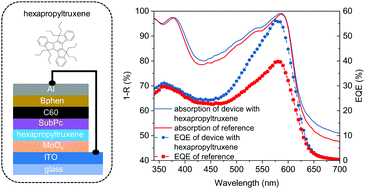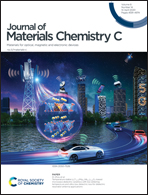Efficiency enhancement of small molecule organic solar cells using hexapropyltruxene as an interface layer†
Abstract
The quenching of excitons in organic solar cells can play a significant role in limiting their power conversion efficiency (PCE). In this article, we investigate the effect of a thin layer of hexapropyltruxene inserted at the interface between the electron donor boron subphthalocyanine chloride (SubPc) and its underlying hole contact in planar heterojunction solar cells. We find that a 3.8 nm hexapropyltruxene interlayer between the molybdenum oxide (MoOx) hole contact and SubPc is sufficient to improve PCE in SubPc/C60 fullerene solar cells from 2.6% to 3.0%, a ∼20% performance improvement. While the absorption stays roughly the same, the comparison of external and internal quantum efficiencies reveals a significant increase in SubPc's contribution to the current for light with wavelengths between 520 and 600 nm. Microstructure and surface morphology assessed with in situ Grazing-Incidence Wide-Angle X-Ray Scattering (GIWAXS) and Atomic Force Microscopy (AFM), are evaluated alongside in situ spectroscopic ellipsometry, and photoluminescence measurements. The microstructural investigations demonstrate changes to the surface and bulk of SubPc grown atop a hexapropyltruxene interlayer indicating that the latter acts as a template layer in a similar way as MoOx. However, the improvement in PCE is found to be mainly via reduced exciton quenching at the MoOx contact with the insertion of the hexapropyltruxene layer.



 Please wait while we load your content...
Please wait while we load your content...